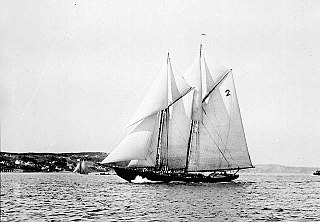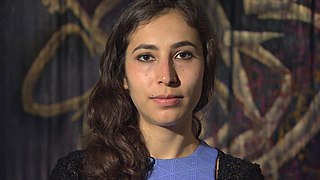Related Research Articles

Lunenburg is a port town on the South Shore of Nova Scotia, Canada. Founded in 1753, the town was one of the first British attempts to settle Protestants in Nova Scotia.

Bluenose was a fishing and racing gaff rig schooner built in 1921 in Nova Scotia, Canada. A celebrated racing ship and fishing vessel, Bluenose under the command of Angus Walters, became a provincial icon for Nova Scotia and an important Canadian symbol in the 1930s, serving as a working vessel until she was wrecked in 1946. Nicknamed the "Queen of the North Atlantic", she was later commemorated by a replica, Bluenose II, built in 1963. The name Bluenose originated as a nickname for Nova Scotians from as early as the late 18th century.

Dr. Habiba Sarābi is a hematologist, politician, and reformer of the post-Taliban reconstruction of Afghanistan. In 2005, she was appointed as Governor of Bamyan Province by President Hamid Karzai, which made her the first Afghan woman to become a governor of any province in the country. She previously served as Afghanistan's Minister of Women's Affairs as well as Minister of Culture and Education. Sarabi has been instrumental in promoting women's rights and representation and environment issues. She belongs to the ethnic Hazara people of Afghanistan. Her last name is sometimes spelled Sarobi.
Afghan Canadians are Canadians with ancestry from Afghanistan. Their ethnic origin may come from any of the ethnic groups of Afghanistan. In the Canada 2016 Census about 83,995 Canadians were from Afghanistan. Due to the political borders at earlier times, some of these Afghan immigrants may have been ethnic Pashtuns, Tajiks, Uzbeks, Hazaras, Turkmens etc.

Viola Irene Desmond was a Canadian civil rights activist and businesswoman of Black Nova Scotian descent. In 1946, she challenged racial segregation at a cinema in New Glasgow, Nova Scotia by refusing to leave a whites-only area of the Roseland Theatre. For this, she was convicted of a minor tax violation for the one-cent tax difference between the seat that she had paid for and the seat that she used, which was more expensive. Desmond's case is one of the most publicized incidents of racial discrimination in Canadian history and helped start the modern civil rights movement in Canada.

Hangama is a popular Afghanistani singer from Afghanistan. When she became a singer her mother chose the name Hangama for her and her real name is Zuhra. She currently lives in Toronto, Canada where she continues her music career. Before her emigration from Afghanistan in the early 1980s, she was counted as one of the most popular female singers of the country. Besides Afghanistan, she is also known in Tajikistan and Iran where she has a fan base

Women's rights in Afghanistan have been varied throughout history. Women officially gained equality under the 1964 constitution. However these rights were taken away in the 1990s through different temporary rulers such as the Taliban during civil war. Especially during the latter's rule, women had very little to no freedom, specifically in terms of civil liberties. Ever since the Taliban regime was removed in late 2001, women's rights have gradually improved under the Islamic Republic of Afghanistan and women are once again de jure equal to men under the 2004 constitution, which was largely based on that from 1964. However, their rights are still complicated by a reactionary view on women by certain classes of school, particularly ruralites, which continue to cause international concern.
This is a timeline of the background of the Taliban's rise to power, from its first actions in October–November 1994 to its capture of Afghanistan's capital, Kabul in September 1996. It details the Taliban movement's origins in Pashtun nationalism, and briefly relates its ideological underpinnings with that of broader Afghan society. It details the Taliban's consolidation of power, listing persecutions by the Taliban officials during its five years in power in Afghanistan and during its war with the Northern Alliance.
Ursula Johnson is a multidisciplinary Mi’kmaq artist based in Halifax, Nova Scotia, Canada. Her work combines the Mi’kmaq tradition of basket weaving with sculpture, installation, and performance art. In all its manifestations her work operates as didactic intervention, seeking to both confront and educate her viewers about issues of identity, colonial history, tradition, and cultural practice. In 2017 she won the Sobey Art Award.

Sima Wali was one of the foremost Afghan human rights advocates in the world, serving as an international campaigner for the liberties and empowerment of refugee and internally displaced populations. She was the Chief Executive Officer of Refugee Women in Development (RefWID), Inc., a global non-profit organization that advocated for the civil rights of refugee women and girls fleeing from conflict and for their equitable reintegration into their societies. She was also the vice president of the Sisterhood Is Global Institute, the world’s first feminist think tank.

Malina Suliman, a graffiti artist, metalworker, and painter, was born in Kabul, Afghanistan in 1990. As a child, she and her family were forced to flee her home province to live in Kandahar, Afghan. Her work is considered to challenge traditional Muslim culture like the burqa. According to Suliman, "The burqa is a way of controlling, but in the name of respect. Every culture or religion gives a different name for the burqa. It is honor, culture, and religion. Really, it just controls the woman and keeps her inside." Malina's work has gained the attention of the Taliban and traditional Muslims, resulting in having received threats from the Taliban towards Suliman and her family. The artist was subject to physical threats, rocks have been thrown at her as she conducts her work.

Shamsia Hassani is an Afghan graffiti artist, a fine arts lecturer, and the associate professor of Drawing and Anatomy Drawing at the Kabul University. She has popularized "street art" in the streets of Kabul and has exhibited her art in several countries including India, Iran, Germany, United States of America, Switzerland, Vietnam, Norway, Denmark, Turkey, Italy, Canada, and in diplomatic missions in Kabul. Hassani paints graffiti in Kabul to bring awareness to the war years. In 2014, Hassani was named one of FP's top 100 global thinkers.

Susanna Heller is a painter, currently living and working in Brooklyn, New York. Born in New York City and raised in Montreal, she studied art in Halifax, Nova Scotia. She was a landed immigrant in Canada until 2006. She exhibits her work regularly in New York and in Toronto. She is known equally in Canada and the United States for her contributions to contemporary art as a painter. Her work is most well known for depictions of cities, primarily New York City.

Laurie Swim, BFA, is a Canadian visual artist, best known for her quilt art. Her work can be found in the permanent collections of the New York Museum of Arts and Design, the Nova Scotia Art Bank, the Nova Scotia Designer Crafts Council, the Ontario Workers Arts and Heritage Centre, and in private collections. She won the Portia White Prize in 2013.
Katie Vida is an American interdisciplinary artist, curator and arts educator based in Brooklyn, New York. She is best known for her performance art, installation art, film, and sound art but also known to create paintings and sculptures.

Homeira Qaderi is an Afghan writer, activist and educator. Her name is also written in English as Homeyra.
Mary Marguerite Porter Zwicker was a Canadian artist and art promoter from Halifax, Nova Scotia. Known for her watercolor paintings of landscapes and villages in Nova Scotia, Zwicker exhibited her work at the Royal Canadian Academy of Arts, the Montreal Art Association, and the Art Gallery of Nova Scotia. Together with her husband, Leroy Zwicker, she owned and operated Zwicker's Gallery; for most of the 20th century, Zwicker's Gallery was the only Halifax gallery that routinely held art exhibits open to the public. It still operates.
Roya Rahmani is an Afghan diplomat who has served as Afghanistan's first female ambassador to the United States and non-resident ambassador to Mexico, Argentina, Colombia, and the Dominican Republic since December 2018. From 2016 to 2018, she served as Afghanistan's first female ambassador to Indonesia, first ever ambassador to the Association of Southeast Asian Nations, and non-resident ambassador to Singapore.
Abdul Samad Amiri was an Afghan human rights activist, whose 2019 murder at the hands of the Taliban was widely reported in the country's media.
Farahnaz Forotan is an Afghan journalist and women's rights activist. She moved to Iran together with her family during the Mujahideen regime. Forotan returned back to Afghanistan in 2001, but took refuge in France in 2020 after being included on a Taliban hit list.
References
- ↑ "Hangama Amiri". Whitney and Betty MacMillan Center for International and Area Studies at Yale. Retrieved 7 April 2019.
- 1 2 3 4 5 6 Shuaib, Pary (17 August 2017). "Feminist Afghan-Canadian Artist Uses Her Brush To Advocate For Women's Rights". Women You Should Know®. Retrieved 3 April 2019.
- 1 2 3 4 5 6 7 Leeder, Jessica (7 August 2018). "Nova Scotia artist Hangama Amiri is at home with the sea". The Globe and Mail. Retrieved 1 April 2019.
- 1 2 3 4 5 Paterson, Lisa (14 November 2015). "Afghan-Canadian artist 'very honoured' to have won Fulbright grant". CBC News. Retrieved 1 April 2019.
- 1 2 McClain, Greta (10 December 2012). "Afghan Canadian artist brings plight of Afghan women to the world". Digital Journal. Retrieved 7 April 2019.
- ↑ "Long Road Projects - Artist-in-Residence". Long Road Projects. Retrieved 7 February 2020.